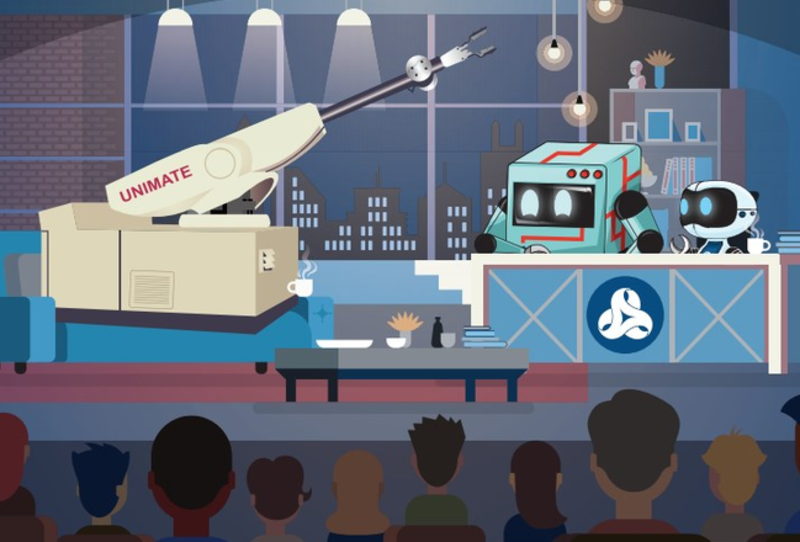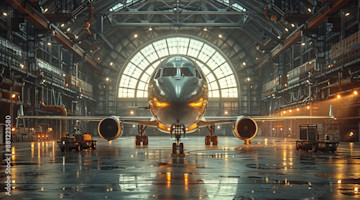In 1963, Johnny Carson invited Joseph Engelberger, the man who later became known as the father of modern robotics, onto the stage of “The Tonight Show.” Next to them was a 3000-pound hydraulically actuated behemoth introduced as the Unimate. The giant machine played golf better than Carson. It poured a beer like in the commercials. The Unimate even ended the show by leading the band.
This investigation into the origins of robotics will reveal the strange evolution and colorful minds that brought us the manufacturing innovations on which we now rely.
The First Robotic Arm
Invented by George Devol (who created the barcode, the automatic door, and a peculiar microwaved-hot-dog vending machine), the Unimate amazed the audience of “The Tonight Show.” Unknown to them at the time, it would become the first in a long line of robotic arms to revolutionize modern manufacturing.
Devol and Engelberger created the first modern robotic startup in 1961, Unimation Inc. It was based on Devol’s 1954 patent of his Programmed Article Transfer machine. Pioneers in their field, Devol needed someone to find investors and dispel the science fiction fears of the time, and Engelberger needed a genius. Together, the pair showed the world why robotics was the future.
Booting Up Unimation
It took 19 years and over 35 rejections for Unimation to turn a profit. This may be no surprise to entrepreneurs; even today, companies struggle to balance advertising with cash flow. But good ideas extend beyond failed startups, and luckily, Unimation found its success with its first partnership with .
The Unimate cut its teeth at a casting plant in Trenton, New Jersey, then spot-welding factories in Ohio. However, Engelberger found true potential overseas: The partnership between Unimation and in 1968 provided the funding to commercialize the robot arm. More importantly, it ignited the hotbed that was – and still is – the Japanese robotics industry.
Today, one of the largest industrial robotics players in the world, (Fuji Automatic Numerical Control), is Japanese, and Asia remains the largest industrial robot market, with over 405,000 units installed in 2022 and an operational stock of nearly 2 million units across China and Japan alone.
Hand-Coding to Hand-Holding
Did you know that the Unimate was the first no-code robot? It was programmed by manually setting switches, timers, and motion controls at set positions that were saved on a basic memory system.
However, Unimation’s acquisition of Stanford startup Vicarm in the 1970s brought in digital code, dropping the physical model. This was the first Programmable Universal Machine for Assembly, better known today as the PUMA. After the shift to this design methodology, translating software between systems became a consistent pain point for engineers.
To solve the language barriers today, designers now push toward (or maybe back to) no-code programming. A person with a teach pendant can show a robot arm what to do by physically guiding the end effector. This simplification shows how the robotics industry is closing the skills gap workers face in robotics, all thanks to some human-centric design.
Tortoises, Vacuums, Warehouses
Did you know the first autonomous mobile robots (AMRs) were built by a neuroscientist in the 1950s? These simple robot “tortoises” are the ancestors of the Roomba and nearly all industrial AMRs.
W. Grey Walter originally came from the world of biology. He was the first to discover brain tumors using the electroencephalograph (EEG) machine and uncovered patterns in the brain’s electrical potentials. This research spurred Walter’s interest in robotics, along with his growing list of colleagues in the field of cybernetics.
Considered his greatest contribution to the field, robots Elmer and Elsie (a somewhat convoluted acronym of electro-mechanical robots, light sensitive, with internal and external stability) were prototyped by Walter in the late 1940s and improved in 1951 with the help of electrical engineer W.J. “Bunny” Warren. Walter gave them the species name Machina speculatrix and treated them as a mechanical offshoot of the tortoise family due to their protective, shell-like covers.
He said that their two vacuum tubes functioned as the two neurons of their simplified brain. The robot had primitive vision via a rotating photoelectric cell that sought out light sources. A set of three wheels acted as its legs, and a dome connected to contact switches gave it protection and a means of avoiding obstacles. Elmer and Elsie even docked themselves back into their charging stations when their batteries were low.
After studying their behavior, Walter declared that Elmer and Elsie “exhibit free will.”
The Exploration Gene
If Walter thought Elmer and Elsie were conscious, imagine his reaction to ’s Roomba. Unlike automated guided vehicles (AGVs), AMRs navigate the world by responding to their environment without direct guidance. This trait began with Walter’s tortoises and continues to be passed down to the robot vacuum and all other AMRs.
This begs an interesting question: Just how big has the Machina family tree gotten? Considering the global AMR market is expected to reach more than $10.5 billion by 2028 and that there are more than 20 million Roombas globally, it probably has more than a few branches at this point.
In Our Image
The robotic arm and AMRs are practical and efficient, but not yet entirely captivating. Investors saw profit in these robots, but it was all still cold and distant. If we go back further in history, we see that our imaginations have always been set on true robotic companionship.
Some such examples were unveiled at the 1939 New York World’s Fair. Two machines, Elektro, a humanoid robot, and his faithful, four-legged, chromed companion, Sparko, brought to life the science fiction of the time. With looks heavily inspired by 1927’s “Metropolis,” they were more marionettes than robots, but both could walk and respond to preset commands.
A crowd of enchanted onlookers watched Elektro move “under his own power” and listened as he quipped about the attractive women in the crowd while smoking a cigarette (truly a product of his time). Sparko is remembered for an admittedly false legend that he was struck by a car after chasing its headlights. Despite embellishments, the tall tale illustrates the desire for responsive, lifelike robotics, even before major advancements.
Elektro to Atlas, Sparko to Spot
Echoes of Elektro and Sparko are seen in and , two robots that capture the same wonder of the 1939 World’s Fair. If you haven’t seen these two in action, you should. The bipedal humanoid Atlas flips, jumps, runs, and even dances. The quadruped Spot has similar functionality but is available for purchase and is commonly used for industrial perimeter inspections and security.
These robots have so captured the public’s attention that the esteemed Adam Savage of “Mythbusters” fame created a video of a Spot-pulled rickshaw, artistically blending old and new technology. At MIT, Spot has been paired with large language models to become an automatic tour guide, cracking jokes with the crowd. The robo-dog has helped search rubble in an NYC garage collapse. It has even made several appearances at , where it showed off its impressive enterprise asset management capabilities.
If Sparko could see his great-great-grandchild, he’d bark with delight; as for Atlas, Elektro would probably scoff and say, “Cool it, toots.”
Rhythms of History
Our shared history with robotics may hint at our continued future. Once thought of as products, and then perhaps free agents, and then even colleague cooperators, robots are becoming more integrated into our everyday lives. The future of robotics holds many things, including:
No-code robotic arm sequencing, lowering the skills gap needed to implement robots in industrial application.
Smarter AMRs that can navigate environments and perform more complicated tasks, all with less human input.
Bipedal and quadruped robots that can act – and even think – like us, giving us our dreams of true artificial companions.
And so much more. It’s an exciting and brave new world that looks much sunnier than those suggested by Asimov, Bradbury, and the rest. Make sure you stay tuned for IMTS 2024, where some new robots may just make some history of their own.
To read the rest of the Automation & Robotics Issue of MT Magazine, click .









